Linlong Wu
Scatterer Localization Using Multi-Bounce Paths
Sep 16, 2025Abstract:Indoor sensing is challenging because of the multi-bounce effect, spherical wavefront, and spatial nonstationarity (SNS) of the near-field effect. This paper addresses radio-based environment sensing considering these issues. Specifically, graph theory (GT) is used to model the multi-bounce propagation of the near field. In this manner, indoor reflectors/scatterers are modeled as vertices in a propagation graph, the multi-bounce paths are modeled by the edges linking the vertices. Besides, the coupled multipath parameters in the near field, i.e., range and angles, are denoted directly by the coordinates of vertices. Then, the space-alternating generalized expectation-maximization (SAGE) algorithm is adapted to the proposed Graph theory-based dictionary-aided Multi-bounce SAGE (GM-SAGE), where the searching parameters including range and angle of departure/arrival (AoD/AoA) are transformed to the coordinates of scatterers in the graph. The proposed algorithm is validated through measurement-calibrated ray tracing (RT) in a complex indoor office. The results demonstrate that the proposed GM-SAGE can deal with multi-bounce channels.
On the Performance Analysis of Momentum Method: A Frequency Domain Perspective
Nov 29, 2024Abstract:Momentum-based optimizers are widely adopted for training neural networks. However, the optimal selection of momentum coefficients remains elusive. This uncertainty impedes a clear understanding of the role of momentum in stochastic gradient methods. In this paper, we present a frequency domain analysis framework that interprets the momentum method as a time-variant filter for gradients, where adjustments to momentum coefficients modify the filter characteristics. Our experiments support this perspective and provide a deeper understanding of the mechanism involved. Moreover, our analysis reveals the following significant findings: high-frequency gradient components are undesired in the late stages of training; preserving the original gradient in the early stages, and gradually amplifying low-frequency gradient components during training both enhance generalization performance. Based on these insights, we propose Frequency Stochastic Gradient Descent with Momentum (FSGDM), a heuristic optimizer that dynamically adjusts the momentum filtering characteristic with an empirically effective dynamic magnitude response. Experimental results demonstrate the superiority of FSGDM over conventional momentum optimizers.
Hybrid Precoder Design for Angle-of-Departure Estimation with Limited-Resolution Phase Shifters
Dec 26, 2023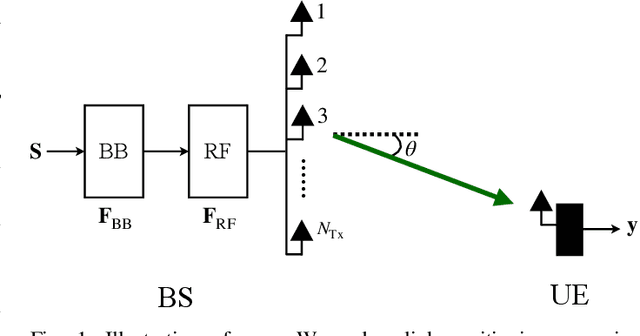
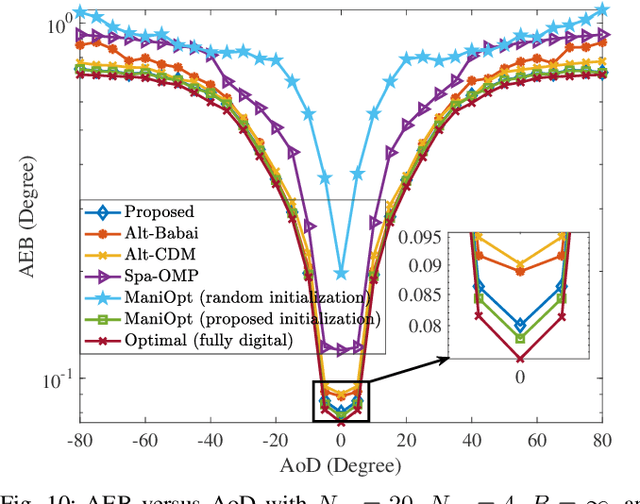
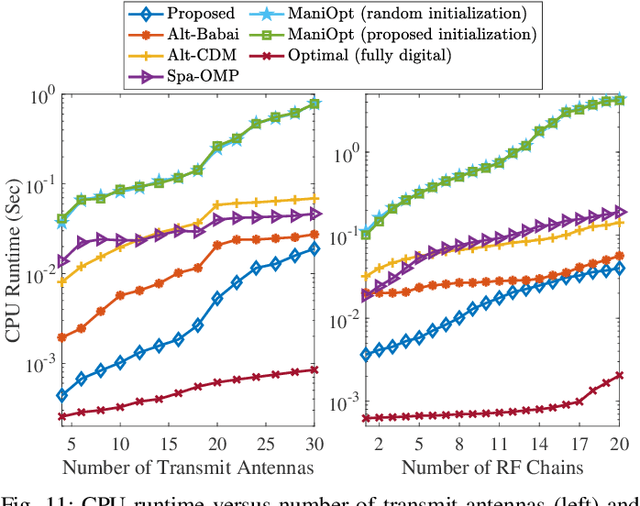
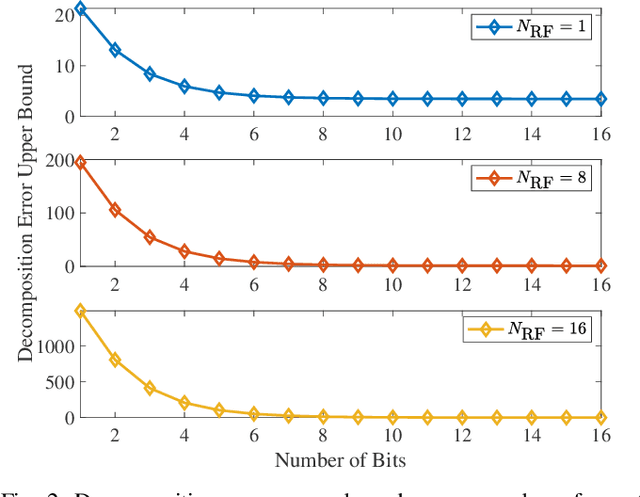
Abstract:Hybrid analog-digital beamforming stands out as a key enabler for future communication systems with a massive number of antennas. In this paper, we investigate the hybrid precoder design problem for angle-of-departure (AoD) estimation, where we take into account the practical constraint on the limited resolution of phase shifters. Our goal is to design a radio-frequency (RF) precoder and a base-band (BB) precoder to estimate AoD of the user with a high accuracy. To this end, we propose a two-step strategy where we first obtain the fully digital precoder that minimizes the angle error bound, and then the resulting digital precoder is decomposed into an RF precoder and a BB precoder, based on the alternating optimization and the alternating direction method of multipliers. Besides, we derive the quantization error upper bound and analyse the convergence behavior of the proposed algorithm. Numerical results demonstrate the superior performance of the proposed method over state-of-the-art baselines.
RIS-Aided Wideband Holographic DFRC
May 08, 2023Abstract:To enable non-line-of-sight (NLoS) sensing and communications, dual-function radar-communications (DFRC) systems have recently proposed employing reconfigurable intelligent surface (RIS) as a reflector in wireless media. However, in the dense environment and higher frequencies, severe propagation and attenuation losses are a hindrance for RIS-aided DFRC systems to utilize wideband processing. To this end, we propose equipping the transceivers with the reconfigurable holographic surface (RHS) that, different from RIS, is a metasurface with an embedded connected feed deployed at the transceiver for greater control of the radiation amplitude. This surface is crucial for designing compact low-cost wideband wireless systems, wherein ultra-massive antenna arrays are required to compensate for the losses incurred by severe attenuation and diffraction. We consider a novel wideband DFRC system equipped with an RHS at the transceiver and a RIS reflector in the channel. We jointly design the digital, holographic, and passive beamformers to maximize the radar signal-to-interference-plus-noise ratio (SINR) while ensuring the communications SINR among all users. The resulting nonconvex optimization problem involves maximin objective, constant modulus, and difference of convex constraints. We develop an alternating maximization method to decouple and iteratively solve these subproblems. Numerical experiments demonstrate that the proposed method achieves better radar performance than non-RIS, random-RHS, and randomly configured RIS-aided DFRC systems.
Relative Entropy-Based Constant-Envelope Beamforming for Target Detection in Large-Scale MIMO Radar With Low-Resoultion ADCs
Jan 19, 2023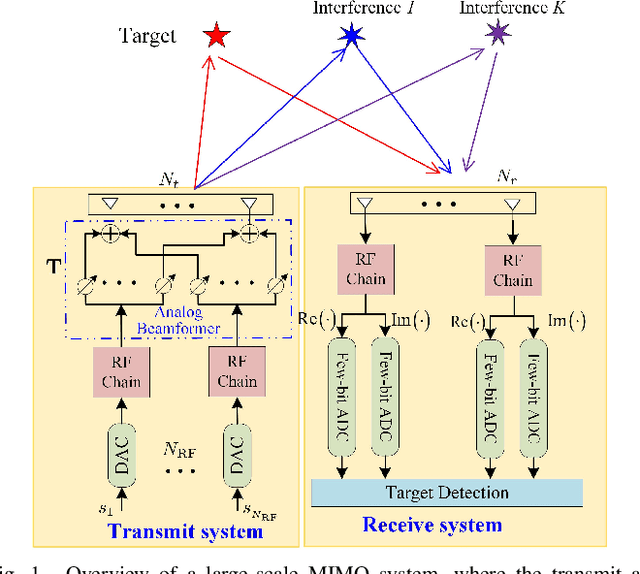
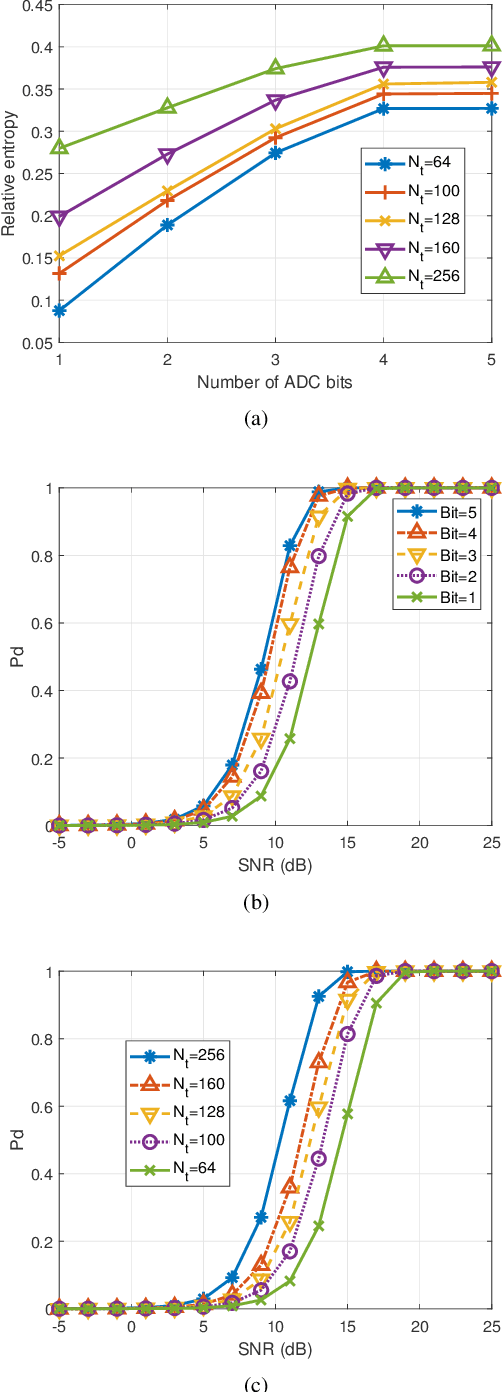
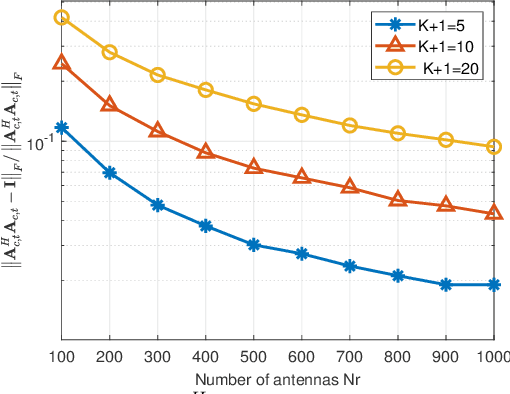
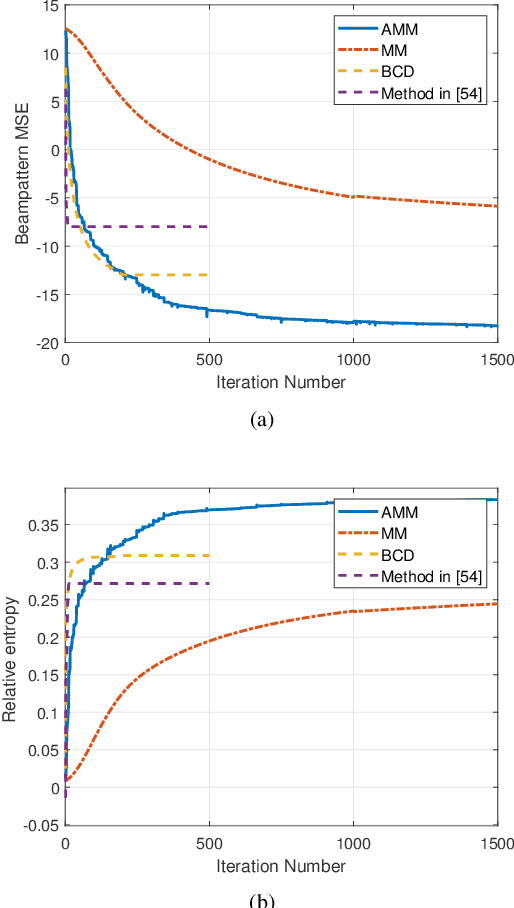
Abstract:Hybrid digital/analog architecture and low-resolution analog-to-digital/digital-to-analog converters (ADCs /DACs) are two low-cost implementations for large-scale millimeter wave (mmWave) systems. In this paper, we investigate the problem of constant-envelope transmit beamforming for large-scale multiple-input multiple-output (MIMO) radar system, where the transmit array adopts a hybrid digital/analog architecture with a small number of RF chains and the receive array adopts a fully digital architecture with low-resolution ADCs. We derive the relative entropy between the probability density functions associated with the two test hypotheses under low-resolution ADCs. We formulate our optimization problem by maximizing the relative entropy, subject to the constant envelope and orthogonality constraints. To suboptimally solve the resultant problem, a two-stage framework is developed. In the first stage, we optimize the transmit power at the directions of the target and clutter. In the second stage, an efficient iterative algorithm based on majorization-minimization is presented to obtain the constant-envelope beamformer according to the attained transmit power. Specifically, we apply a quadratic function as the minorizer, leading to a low-complexity solution at each iteration. In addition, to further facilitate low-cost implementation of the constant-envelope beamformer, we consider the problem of one-bit beamforming design and propose an efficient iterative method based on the Nesterov-like gradient method to solve it. Numerical simulations are provided to demonstrate the effectiveness of the proposed schemes.
Sparse Array Design for Dual-Function Radar-Communications System
Jan 02, 2023



Abstract:The problem of sparse array design for dual-function radar-communications is investigated. Our goal is to design a sparse array which can simultaneously shape desired beam responses and serve multiple downlink users with the required signal-to-interference-plus-noise ratio levels. Besides, we also take into account the limitation of the radiated power by each antenna. The problem is formulated as a quadratically constrained quadratic program with a joint-sparsity-promoting regularization, which is NP-hard. The resulting problem is solved by the consensus alternating direction method of multipliers, which enjoys parallel implementation. Numerical simulations exhibit the effectiveness and superiority of the proposed method which leads to a more power-efficient solution.
Improving Pulse-Compression Weather Radar via the Joint Design of Subpulses and Extended Mismatch Filter
Sep 27, 2022

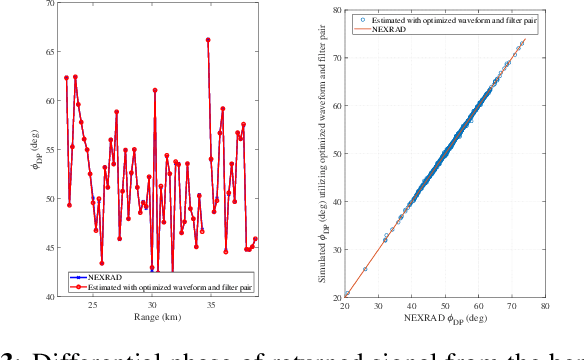
Abstract:Pulse compression can enhance both the performance in range resolution and sensitivity for weather radar. However, it will introduce the issue of high sidelobes if not delicately implemented. Motivated by this fact, we focus on the pulse compression design for weather radar in this paper. Specifically, we jointly design both the subpulse codes and extended mismatch filter based on the alternating direction method of multipliers (ADMM). This joint design will yield a pulse compression with low sidelobes, which equivalently implies a high signal-to-interference-plus-noise ratio (SINR) and a low estimation error on meteorological reflectivity. The experiment results demonstrate the efficacy of the proposed pulse compression strategy since its achieved meteorological reflectivity estimations are highly similar to the ground truth.
Hybrid Beamforming in mmWave Dual-Function Radar-Communication Systems: Models, Technologies, and Challenges
Sep 13, 2022



Abstract:As a promising technology in beyond-5G (B5G) and 6G, dual-function radar-communication (DFRC) aims to ensure both radar sensing and communication on a single integrated platform with unified signaling schemes. To achieve accurate sensing and reliable communication, large-scale arrays are anticipated to be implemented in such systems, which brings out the prominent issues on hardware cost and power consumption. To address these issues, hybrid beamforming (HBF), beyond its successful deployment in communication-only systems, could be a promising approach in the emerging DFRC ones. In this article, we investigate the development of the HBF techniques on the DFRC system in a self-contained manner. Specifically, we first introduce the basics of the HBF based DFRC system, where the system model and different receive modes are discussed with focus. Then we illustrate the corresponding design principles, which span from the performance metrics and optimization formulations to the design approaches and our preliminary results. Finally, potential extension and key research opportunities, such as the combination with the reconfigurable intelligent surface, are discussed concisely.
Multi-IRS-Aided Doppler-Tolerant Wideband DFRC System
Jul 05, 2022



Abstract:Intelligence reflecting surface (IRS) is recognized as the enabler of future dual-function radar-communications (DFRC) for improving spectral efficiency, coverage, parameter estimation, and interference suppression. Prior studies on IRS-aided DFRC focus on either narrowband processing, single-IRS deployment, static targets, non-clutter scenario, or under-utilized line-of-sight (LoS) and non-line-of-sight (NLoS) paths. In this paper, we address the aforementioned shortcomings by optimizing a wideband DFRC system that comprises multiple IRSs and a dual-function base station that jointly processes the LoS and NLoS wideband multi-carrier signals to extract communications symbols and moving target parameters in the presence of clutter. We formulate the transmit and IRS beamformer design as the maximization of the worst-case radar signal-to-interference-plus-noise ratio (SINR) subject to transmit power and communications SINR. We tackle this nonconvex problem under the alternating optimization framework, where the subproblems are solved by a combination of the Dinkelbach algorithm, consensus alternating direction method of multipliers, and Riemannian steepest decent. Our numerical experiments show that the proposed multi-IRS-aided wideband DFRC provides over $6$ dB radar SINR and $40$% improvement in target detection over a single-IRS system.
Double-Phase-Shifter based Hybrid Beamforming for mmWave DFRC in the Presence of Extended Target and Clutters
Dec 07, 2021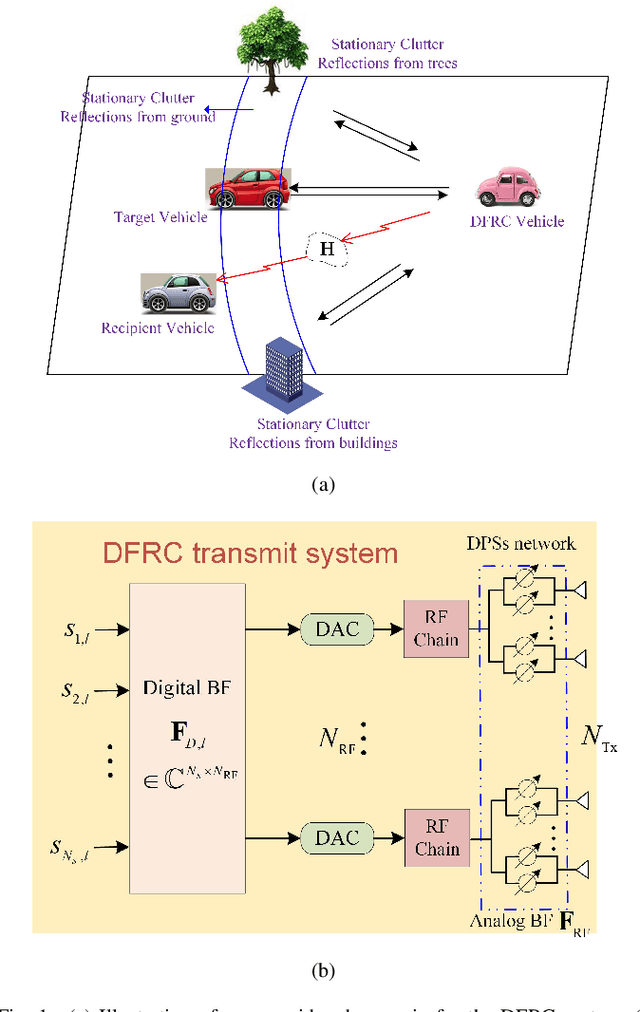
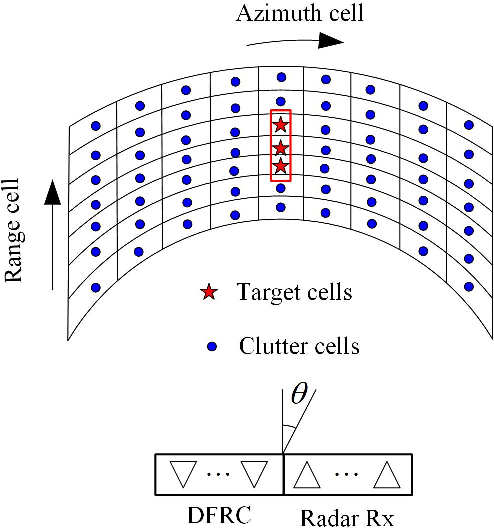
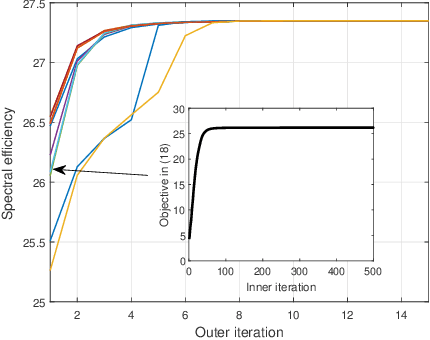
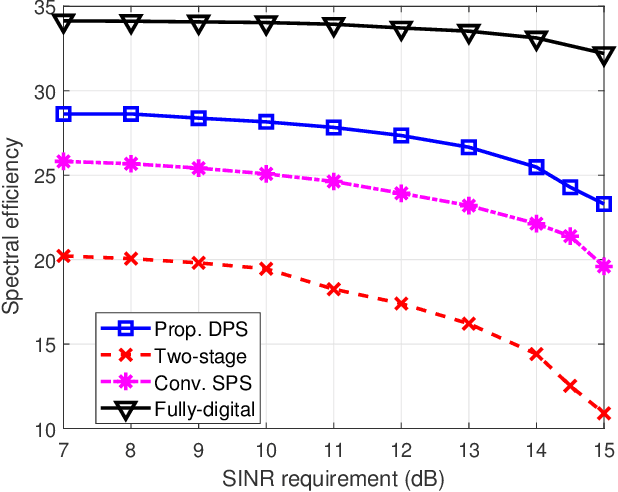
Abstract:In millimeter-wave (mmWave) dual-function radar-communication (DFRC) systems, hybrid beamforming (HBF) is recognized as a promising technique utilizing a limited number of radio frequency chains. In this work, in the presence of extended target and clutters, a HBF design based on the subarray connection architecture is proposed for a multiple-input multiple-output (MIMO) DFRC system. In this HBF, the double-phase-shifter (DPS) structure is embedded to further increase the design flexibility. We derive the communication spectral efficiency (SE) and radar signal-to-interference-plus-noise-ratio (SINR) with respect to the transmit HBF and radar receiver, and formulate the HBF design problem as the SE maximization subjecting to the radar SINR and power constraints. To solve the formulated nonconvex problem, the joinT Hybrid bRamforming and Radar rEceiver OptimizatioN (THEREON) is proposed, in which the radar receiver is optimized via the generalized eigenvalue decomposition, and the transmit HBF is updated with low complexity in a parallel manner using the consensus alternating direction method of multipliers (consensus-ADMM). Furthermore, we extend the proposed method to the multi-user multiple-input single-output (MU-MISO) scenario. Numerical simulations demonstrate the efficacy of the proposed algorithm and show that the solution provides a good trade-off between number of phase shifters and performance gain of the DPS HBF.
 Add to Chrome
Add to Chrome Add to Firefox
Add to Firefox Add to Edge
Add to Edge